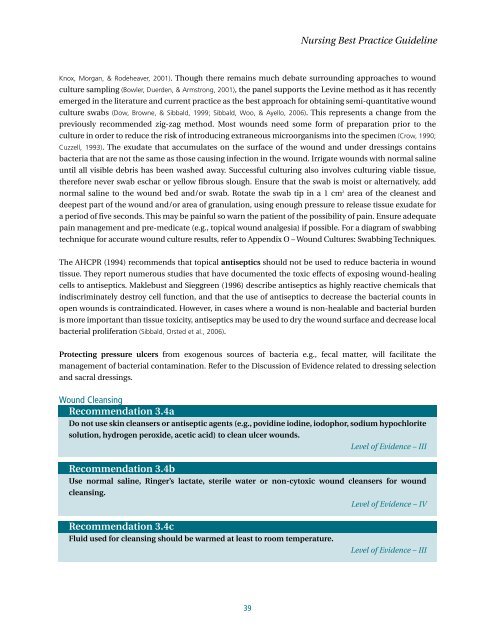RNAO BPG Pressure Ulcers Stage I to IV - Faculty of Health ...
RNAO BPG Pressure Ulcers Stage I to IV - Faculty of Health ...
RNAO BPG Pressure Ulcers Stage I to IV - Faculty of Health ...
You also want an ePaper? Increase the reach of your titles
YUMPU automatically turns print PDFs into web optimized ePapers that Google loves.
Nursing Best Practice GuidelineKnox, Morgan, & Rodeheaver, 2001). Though there remains much debate surrounding approaches <strong>to</strong> woundculture sampling (Bowler, Duerden, & Armstrong, 2001), the panel supports the Levine method as it has recentlyemerged in the literature and current practice as the best approach for obtaining semi-quantitative woundculture swabs (Dow, Browne, & Sibbald, 1999; Sibbald, Woo, & Ayello, 2006). This represents a change from thepreviously recommended zig-zag method. Most wounds need some form <strong>of</strong> preparation prior <strong>to</strong> theculture in order <strong>to</strong> reduce the risk <strong>of</strong> introducing extraneous microorganisms in<strong>to</strong> the specimen (Crow, 1990;Cuzzell, 1993). The exudate that accumulates on the surface <strong>of</strong> the wound and under dressings containsbacteria that are not the same as those causing infection in the wound. Irrigate wounds with normal salineuntil all visible debris has been washed away. Successful culturing also involves culturing viable tissue,therefore never swab eschar or yellow fibrous slough. Ensure that the swab is moist or alternatively, addnormal saline <strong>to</strong> the wound bed and/or swab. Rotate the swab tip in a 1 cm 2 area <strong>of</strong> the cleanest anddeepest part <strong>of</strong> the wound and/or area <strong>of</strong> granulation, using enough pressure <strong>to</strong> release tissue exudate fora period <strong>of</strong> five seconds. This may be painful so warn the patient <strong>of</strong> the possibility <strong>of</strong> pain. Ensure adequatepain management and pre-medicate (e.g., <strong>to</strong>pical wound analgesia) if possible. For a diagram <strong>of</strong> swabbingtechnique for accurate wound culture results, refer <strong>to</strong> Appendix O – Wound Cultures: Swabbing Techniques.The AHCPR (1994) recommends that <strong>to</strong>pical antiseptics should not be used <strong>to</strong> reduce bacteria in woundtissue. They report numerous studies that have documented the <strong>to</strong>xic effects <strong>of</strong> exposing wound-healingcells <strong>to</strong> antiseptics. Maklebust and Sieggreen (1996) describe antiseptics as highly reactive chemicals thatindiscriminately destroy cell function, and that the use <strong>of</strong> antiseptics <strong>to</strong> decrease the bacterial counts inopen wounds is contraindicated. However, in cases where a wound is non-healable and bacterial burdenis more important than tissue <strong>to</strong>xicity, antiseptics may be used <strong>to</strong> dry the wound surface and decrease localbacterial proliferation (Sibbald, Orsted et al., 2006).Protecting pressure ulcers from exogenous sources <strong>of</strong> bacteria e.g., fecal matter, will facilitate themanagement <strong>of</strong> bacterial contamination. Refer <strong>to</strong> the Discussion <strong>of</strong> Evidence related <strong>to</strong> dressing selectionand sacral dressings.Wound CleansingRecommendation 3.4aDo not use skin cleansers or antiseptic agents (e.g., povidine iodine, iodophor, sodium hypochloritesolution, hydrogen peroxide, acetic acid) <strong>to</strong> clean ulcer wounds.Level <strong>of</strong> Evidence – IIIRecommendation 3.4bUse normal saline, Ringer’s lactate, sterile water or non-cy<strong>to</strong>xic wound cleansers for woundcleansing.Level <strong>of</strong> Evidence – <strong>IV</strong>Recommendation 3.4cFluid used for cleansing should be warmed at least <strong>to</strong> room temperature.Level <strong>of</strong> Evidence – III39
















